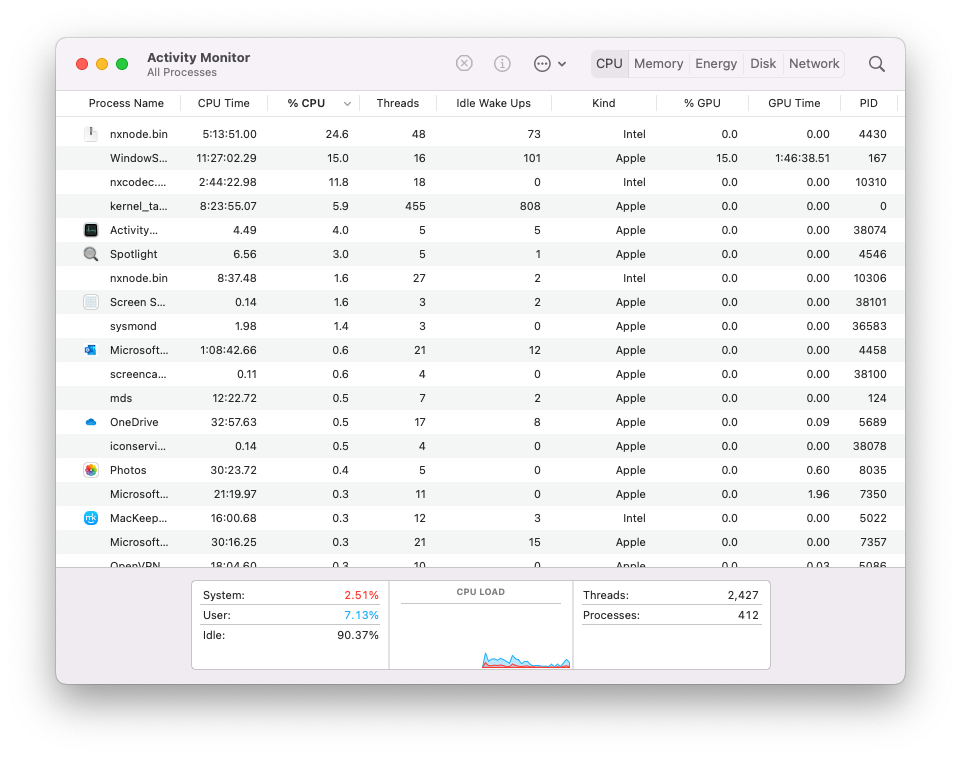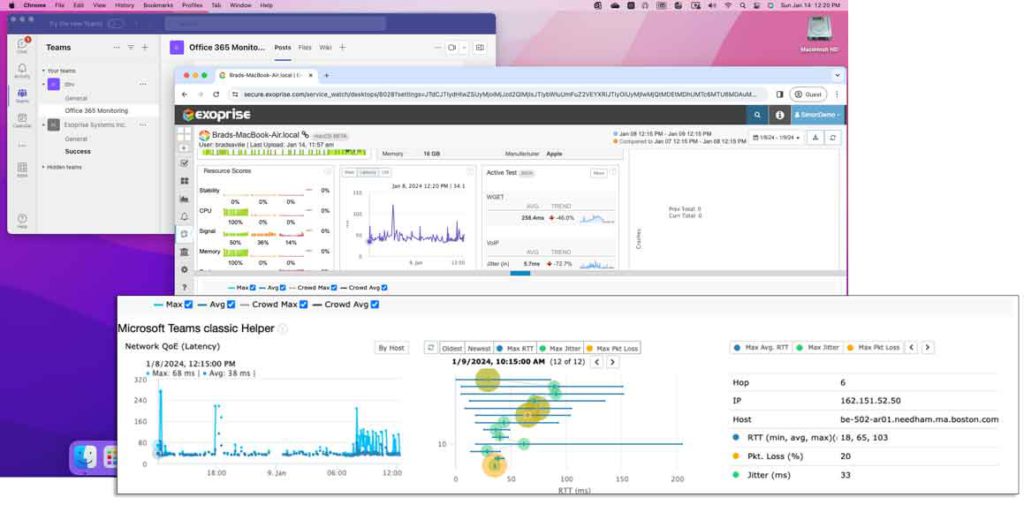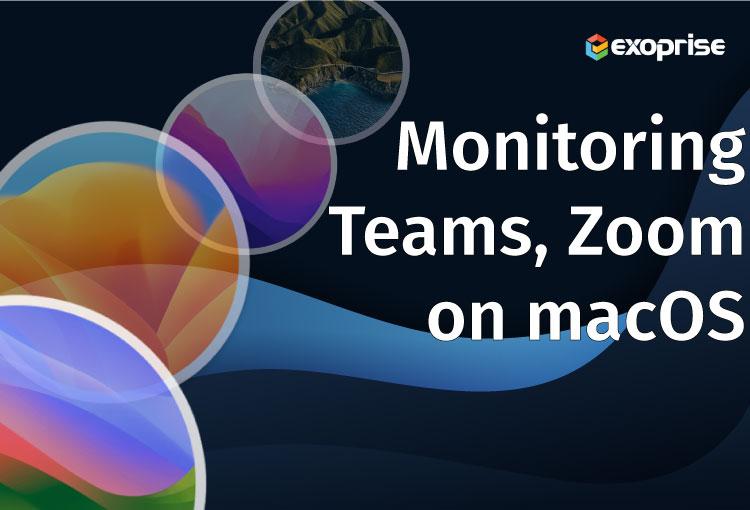Monitoring Teams & Zoom on macOS Devices
When it comes to macOS, monitoring the digital experience brings numerous challenges. When considering these challenges in relation to monitoring such business-critical UCaaS applications like Zoom, Teams or Cisco Webex, the challenges multiply — especially if relying solely on built-in macOS tools.
Considerations for Teams & Zoom
When implementing UCaaS applications such as Teams and Zoom, various factors need to be considered, particularly the quality of service (QoS) and the network platform. Given the stringent requirements for call quality in high-level UCC applications, it is crucial to exercise caution when configuring, maintaining, and monitoring these systems. This is especially true for macOS, as monitoring considerations on this platform adds additional layers of complexity.
Even regardless of monitoring, setting QoS or DSCP for macOS clients like Teams or Zoom seems to be a bit of mystery as evidenced by some of these public facing threads out there:
- https://serverfault.com/questions/992687/setting-dscp-value-on-specific-outgoing-traffic-in-os-x-with-pf
- https://developer.apple.com/forums/thread/109915
It seems like Apple engineers at Apple don’t like having to deal with QoS implementation. This is expected from a consumer oriented, non-enterprise platform. They don’t prioritize features or testing in this area. We’re not saying it’s wrong (obviously, not for them) but just pointing it out.

Conventional methods of monitoring macOS heavily rely on simplistic network tools that lack robustness to adequately monitor high-traffic networks where Teams and Zoom are utilized. Microsoft recommends adhering to a set of network standards and advises organizations to thoroughly assess and prepare their network environment to ensure optimal performance with Teams.
Teams Network Assessment
Microsoft provides various implementation tools for Teams preparation, all of which are found in the Team’s admin center:
- Network Planner helps with assessing networks
- Adviser for Teams provides checklists, guidance, and setup automation for both Microsoft 365 and Office 365 for any needed configuration changes.
- External Name Resolution determines whether all computers can resolve external DNS queries and whether there are any firewall adjustments to be made.
- Ensure your firewalls, routers, and gateways don’t alter or disrupt the NAT addresses and ports for successful UDP resolution.
- Validate NAT pool size, assures that requirements for user connectivity are met.
- Routing to Microsoft data centers is available through the most efficient routing.
Furthermore, when Intrusion Detection and Prevention (IDS/IPS) are in place, Microsoft insists that extra security layers like SASE are tested and ensured to allow and not inhibit Teams traffic:
- Configure split-tunneled VPN is recommended where an alternate traffic bypass for Teams is established
You can test and validate the performance of split-tunneling with Exoprise VPN testing and monitoring - Implement QoS configurations for prioritization of packets to establish high-quality calls.
Oh well, not so much on macOS. Or, good luck, test and verify before you get it working. - Optimizing Wi-Fi is important, as most are access points are easily saturated during Teams meetings of any significant size with a few local attendees
Microsoft provides several standards to achieve through this process. These adjustments include implementing QoS or Wi-Fi Multimedia (WMM), Plan and optimizing the Wi-Fi bands and access point placement, band-steering for dual-band Wi-Fi networks, and correct placement of access points.
You can leverage both CloudReady synthetics and Service Watch Desktop to ensure that Wi-Fi is performing well in this hybrid Windows, macOS environments. - Finally, allow (and test) Web Socket protocol for delivery of the entire range of Teams communication such as chat, call notifications and signaling, presence status changes, and more.
Recommended metric targets by Microsoft are extremely useful for determining Teams monitoring baselines and benchmarks:
- One-way latency < 50ms.
- Latency (RTT or Round-trip Time) < 100ms.
- Burst packet loss < 10% during any 200 ms interval.
- Packet loss < 0.1% during any 15s interval.
- Packet inter-arrival Jitter < 15ms during any 15s interval.
- Packet reorder <0.01% out-of-order packets.
Leveraging synthetic UCaaS testing for Zoom, Teams, and Cisco Webex can assist in proving out these baselines without having to impact end-users or wait around.
Applying UCC Monitoring with macOS
Exoprise offers distinctive monitoring models tailored for both macOS and UCC (Unified Communications & Collaboration) applications. When it comes to synthetics, Teams Audio Videos is specifically monitored. For Zoom, we have UDP/VoIP sensors that will test any of the different AWS regions where Zoom is hosted.
For macOS, hop-by-hop pinpointing is monitored through ICMP (Internet Control Message Protocol) and UDP (User Datagram Protocol) and combines synthetic testing with real user monitoring through Service Watch. As with the rest of the Exoprise platform, metrics are measured and analyzed using Exoprise’s unique crowdsourcing and reporting platform.
Service Watch Active Test, a newly released addition, helps by evaluating macOS network performance proactively from every user’s machine. Active Test utilizing extremely lightweight VoIP tests proactively evaluate UDP and Network Path Performance to Azure, AWS, and other UCaaS locations. Exoprise’s distinct monitoring methodology provides valuable insights into UCC call metrics that are not available elsewhere in the industry.
Furthermore, all the information collected from macOS devices is incorporated into the overall crowdsourced data, which is used for benchmarking and establishing performance baselines according to recommended standards. Comparing performance across the Exoprise client community and internal implementations provides a wealth of information necessary to maintain the highest level of UCC call performance, ultimately contributing to enhanced user satisfaction.
Pinpointing Poor Hops from a macOS Device
On macOS, Apple employs the User Datagram Protocol (UDP) as the network tracing mechanism, which Exoprise incorporates for its real-time diagnosis of Teams and Zoom sessions. Service Watch can also utilize ICMP and TCP/IP-based inspection for flexibility and to match other operating system defaults.
Through testing and historical analysis, Exoprise has concluded that ICMP is often more accurate in the “middle” of the Internet, especially when bridging ISPs and peering networks. UDP can be better for local telemetry, but that depends on the local network type, which can vary depending on where the device sits and what is being diagnosed. This discrepancy arises from the diverse behavior of routers, which discard short Time-to-Live (TTL)-based packets based on their configuration.

Knowing the latencies and packet loss for the client side, gateway, or ISP in advance of an employee reporting a problem is critical to reducing the total cost of ownership for a macOS device and Microsoft 365 or Zoom.
Conclusion
Monitoring the digital experience on macOS comes with its own set of challenges, which become even more complex when monitoring popular UCC applications like Zoom and Teams. The native monitoring tools available on macOS, such as the Network Utility, are limited for managing the complexity of modern networks. However, top DEM solutions such as CloudReady and Service Watch from Exoprise offer comprehensive insights into network performance and overcome these limitations.
When implementing UCC applications, including Teams and Zoom, it is crucial to consider factors such as quality of service and network platform. Microsoft specifically provides implementation tools and recommendations for optimizing performance with Teams, including network planning, DNS resolution, NAT configurations, QoS configurations, and Wi-Fi optimization.
Exoprise offers monitoring models specifically tailored for macOS and UCC applications like Teams and Zoom. Synthetic sensors, combined with real user monitoring, provide comprehensive tracking and analysis of network performance on macOS devices. By incorporating this data into the overall crowdsourced data, Exoprise establishes performance baselines and benchmarks to maintain the highest level of UCC call performance.
This unique monitoring methodology provides valuable insights that are not available elsewhere in the industry, ultimately contributing to enhanced user satisfaction.

